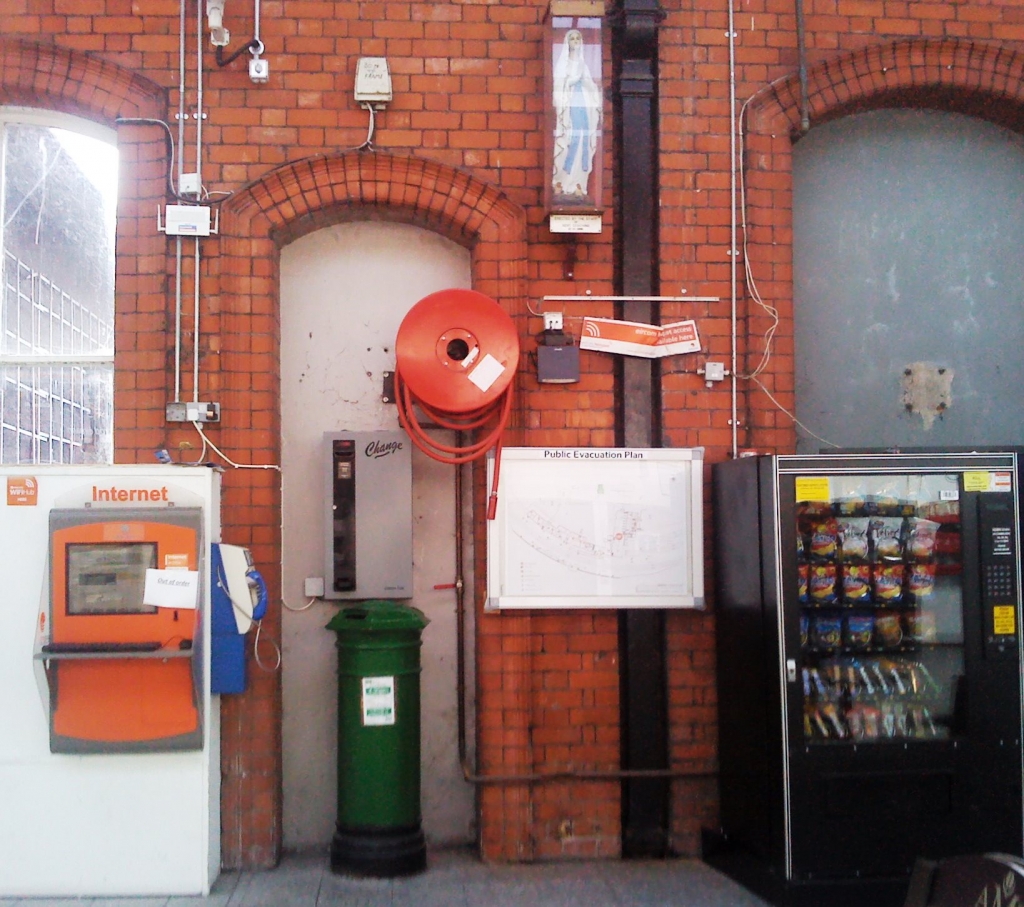Observing what is there at Kent Station
Among the distinct features of Kent Station, Cork city’s train station, is this section of wall which is jam packed with so much stuff: functional and cultural, pragmatic and odd. My interest with this small space, which prompted me to take the photo, highlights the role of basic observation in not only research but in our daily lives.
While the physical limits of a photo can sometimes be rather frustrating, in this case they actually frame the scene perfectly. These different objects have clear functions, many of which make sense in the context of a train station, but a still find it necessary to comment. On this patch of wall there is:
- an internet kiosk (out-of-order) (modern-ish, but increasingly irrelevant with the rise of smartphones),
- a public phone (an utter rarity with the growth in mobile phone ownership in the last 15 years, although their role in places such as trains stations ensures their presence for another while, until they’ll all be stored in museums, right next to the home phone section, complete with hall table),
- a change machine (an object in a symbiotic relationship with the phone/kiosk),
- a post box (a continuing strong feature of the Irish landscape testifying to the role of post and the letters),
- a fire hose (seems a little high to reach in an emergency) and a poster outlining the ‘Public Evacuation Plan’ (although, I doubt many of the public actually check it out),
- a wireless internet router (in many ways a direct challenge to the internet kiosk and even pay phone – and by implication the change machine)
- a vending machine (when everything else is closed),
-
a statue of Our Lady/Blessed Virgin Mary – dubbed ‘Our Lady of Kent Station‘* by Eoin O’Mahoney (check out his excellent blog 53 Degrees) (the Marion statue is another prominent aspect of the Irish landscape; this statue, there since 1966, was on the opposite wall until renovations a few years ago saw it move across – indicated a recent intentional decision to retain this religious/cultural icon),
- a security camera – the bottom of which is visible on the top left (a cog of the constant CCTV-based surveillance in which we lead our urban lives), and,
- the arches and drain pipe (the Station is a pro-typical old train station in many ways, with high pitched roofs, long platforms and ornate red-bricked walls; although, the main platform is curved making it rather distinct).
Although this wall-space is a noteworthy thing to write a short blogpost on, the greater point is the importance of observing the world around us. The world is generally filled with things ready to be noticed and appreciated. Observation was one of the primary skills emphasised in my geography undergraduate courses. It is in truly engaging with the world around us that we can understand it and be motivated to preserve, change or improve it, as required.
A good example of this is in an episode of the podcast 99% Invisible (it explores architectural ideas in a very interesting and insightful way) which highlights the great many public staircases in California. It shows how these fascinating features are generally unknown and under-used; how they can be discovered and explored with enthusiasm; but also, how they can be blocked by private interests and re-opened by committed activists.
Ultimately, while observation is an essential research tool, it is also a duty of the citizen more generally to be observant. Take in what is going on around you, be involved in the world. While the commuters, tourists and people of Cork pass by the wall-space the eclectic collection will remain, or maybe not, have you noticed?
*For more photo’s of statues of Our Lady check out: Shooting Statues
